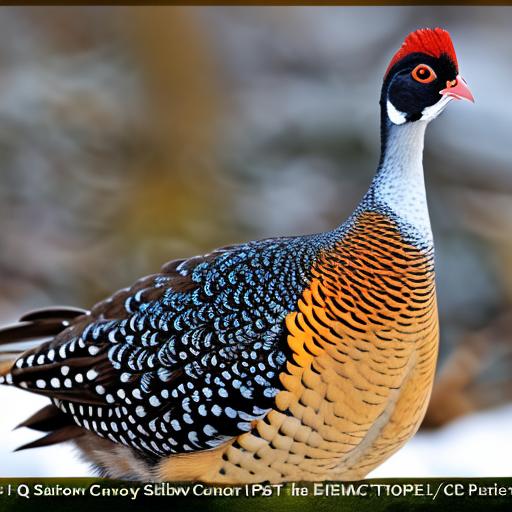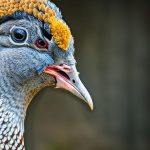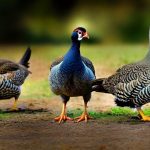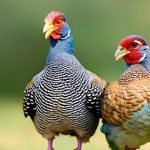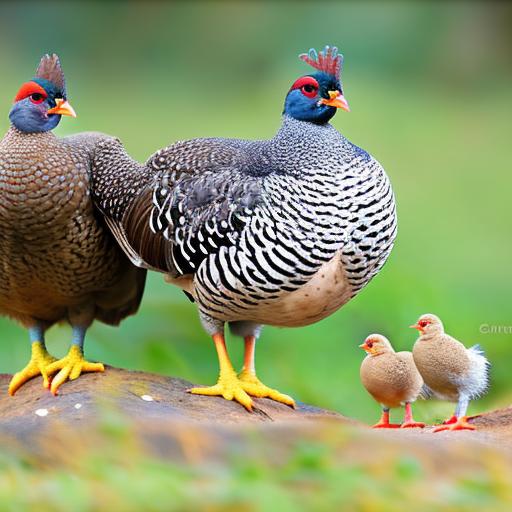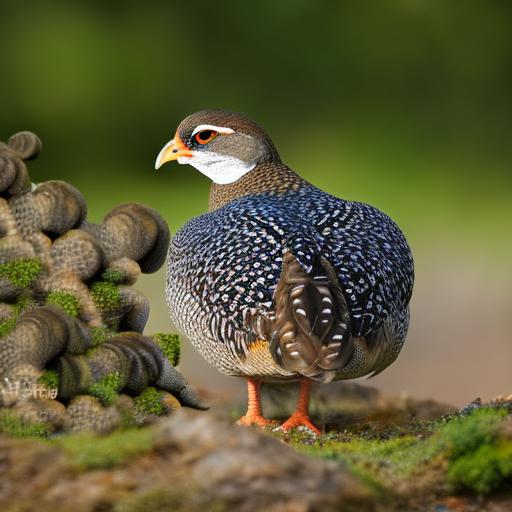Guinea fowl, like many other poultry, have specific needs during the winter months. Understanding these needs is crucial for ensuring the health and well-being of your guinea fowl flock. In winter, guinea fowl require adequate shelter, warmth, access to fresh water, and a balanced diet to help them cope with the cold temperatures. It’s important to recognize that guinea fowl are more cold-hardy than other poultry, but they still need proper care and attention during the winter months. By understanding their needs and taking appropriate measures, you can help your guinea fowl thrive even in the coldest of winters.
Guinea fowl are native to Africa, where they are accustomed to warmer climates. As a result, they are more cold-hardy than other poultry such as chickens, but they still require protection from harsh winter conditions. During the winter months, guinea fowl need a dry and draft-free shelter to roost in at night. They also need access to fresh water and a balanced diet to help them maintain their body temperature and energy levels. By understanding these basic needs, you can take the necessary steps to ensure that your guinea fowl stay healthy and comfortable throughout the winter.
Key Takeaways
- Guinea fowl need protection from cold, wind, and dampness in winter
- Adequate shelter should be provided to protect guinea fowl from harsh weather conditions
- Heat lamps or heaters can be used to keep guinea fowl warm, but with caution to prevent fire hazards
- Access to fresh water is crucial for guinea fowl in winter to prevent dehydration
- A balanced diet with additional nutrients is important for guinea fowl to stay healthy in winter
- Regular monitoring for signs of cold stress is essential to ensure the well-being of guinea fowl
- In extreme cold, additional measures such as insulated shelters or heated perches may be necessary to keep guinea fowl warm
Providing adequate shelter for guinea fowl
One of the most important aspects of caring for guinea fowl in winter is providing them with adequate shelter. A dry and draft-free shelter is essential for protecting guinea fowl from the cold temperatures and harsh weather conditions. The shelter should be well-ventilated to prevent moisture buildup, but it should also be protected from drafts to keep the guinea fowl warm. Additionally, the shelter should be spacious enough to accommodate the entire flock comfortably, with plenty of roosting space for each bird.
When it comes to shelter for guinea fowl in winter, there are several options to consider. A well-constructed coop or barn is an ideal choice for providing protection from the elements. The coop should be insulated and have a solid roof to keep out rain and snow. It’s also important to provide plenty of bedding such as straw or wood shavings to help insulate the floor and keep the guinea fowl warm. If you don’t have a coop or barn, you can also consider using a large doghouse or building a simple shelter out of plywood and lumber. Whatever type of shelter you choose, it’s important to ensure that it provides adequate protection from the cold and wet conditions of winter.
Using heat lamps or heaters to keep guinea fowl warm
In extreme cold temperatures, providing additional heat for guinea fowl may be necessary to keep them warm and comfortable. Heat lamps or heaters can be used in the shelter to provide supplemental warmth for the birds. When using heat lamps or heaters, it’s important to follow safety precautions to prevent fires and ensure the well-being of the guinea fowl. The heat source should be securely installed and positioned away from any flammable materials such as bedding or nesting materials. It’s also important to regularly check the heat source for any signs of damage or malfunction.
When using heat lamps or heaters for guinea fowl in winter, it’s important to monitor the temperature in the shelter to ensure that it remains at a comfortable level for the birds. The ideal temperature for guinea fowl in winter is around 45-50 degrees Fahrenheit. If the temperature drops below this range, supplemental heat may be necessary to prevent cold stress in the birds. However, it’s important not to overheat the shelter, as this can lead to respiratory issues and other health problems for the guinea fowl. By using heat lamps or heaters responsibly and monitoring the temperature in the shelter, you can help your guinea fowl stay warm and healthy throughout the winter months.
Ensuring access to fresh water in winter
Access to fresh water is essential for guinea fowl in winter, as they need water to stay hydrated and maintain their body temperature. In cold temperatures, it’s important to prevent water from freezing to ensure that the birds have access to clean and unfrozen water at all times. There are several options for providing fresh water to guinea fowl in winter, including heated waterers, insulated water containers, and frequent water checks and refills.
Heated waterers are an effective solution for preventing water from freezing in cold temperatures. These devices are designed to keep water at a constant temperature above freezing, ensuring that guinea fowl have access to fresh water at all times. Insulated water containers can also help prevent freezing by retaining heat and protecting the water from cold temperatures. Additionally, regularly checking and refilling water containers throughout the day can help ensure that guinea fowl always have access to clean and unfrozen water. By taking these measures, you can help your guinea fowl stay hydrated and healthy throughout the winter.
Providing a balanced diet for guinea fowl in winter
A balanced diet is essential for maintaining the health and well-being of guinea fowl in winter. During the colder months, guinea fowl require a diet that provides them with the necessary nutrients and energy to cope with the cold temperatures. This includes a mix of grains, seeds, fruits, vegetables, and protein sources such as insects or mealworms. It’s important to provide a varied diet that meets the nutritional needs of guinea fowl and helps them stay healthy throughout the winter.
Grains such as corn, oats, and wheat are excellent sources of energy for guinea fowl in winter. These grains can be provided as whole kernels or ground into a coarse meal for easier consumption. Seeds such as sunflower seeds and millet can also be included in their diet to provide additional energy and essential fatty acids. Fruits and vegetables such as apples, carrots, and leafy greens can provide important vitamins and minerals to support the overall health of guinea fowl during the winter months. Additionally, offering protein sources such as insects or mealworms can help supplement their diet and provide essential amino acids for muscle development and overall health.
Monitoring guinea fowl for signs of cold stress

During the winter months, it’s important to monitor guinea fowl for signs of cold stress to ensure that they are healthy and comfortable. Cold stress can manifest in various ways, including shivering, huddling together for warmth, reduced activity, decreased egg production, and changes in behavior. By regularly observing your guinea fowl and looking out for these signs, you can take appropriate measures to address any issues and ensure their well-being.
If you notice any signs of cold stress in your guinea fowl, it’s important to take action to help them stay warm and comfortable. This may include providing additional heat in the shelter, adjusting their diet to provide more energy-rich foods, or making changes to their environment to protect them from harsh weather conditions. By addressing signs of cold stress promptly and effectively, you can help your guinea fowl stay healthy and resilient throughout the winter.
Implementing additional measures to keep guinea fowl warm in extreme cold
In extreme cold temperatures, it may be necessary to implement additional measures to keep guinea fowl warm and comfortable. This can include using insulation in the shelter, providing windbreaks or barriers to protect them from harsh winds, and using deep bedding materials such as straw or wood shavings to help insulate the floor of the shelter. Additionally, providing extra food and energy-rich treats can help support their nutritional needs and provide them with additional warmth.
Insulating the shelter can help retain heat and protect guinea fowl from cold temperatures. This can be done by adding insulation material such as foam board or fiberglass insulation to the walls and ceiling of the shelter. Windbreaks or barriers can also be used to protect guinea fowl from harsh winds and reduce heat loss from their environment. By implementing these additional measures, you can help your guinea fowl stay warm and comfortable even in extreme cold temperatures.
In conclusion, caring for guinea fowl in winter requires an understanding of their specific needs and taking appropriate measures to ensure their health and well-being. By providing adequate shelter, using heat lamps or heaters when necessary, ensuring access to fresh water, providing a balanced diet, monitoring for signs of cold stress, and implementing additional measures in extreme cold temperatures, you can help your guinea fowl thrive even in the coldest of winters. With proper care and attention, your guinea fowl can stay healthy and resilient throughout the winter months.
When it comes to keeping guinea fowl warm in winter, proper housing is essential. A well-insulated coop can make a significant difference in their comfort and well-being during the colder months. For tips on creating a cozy and secure coop, check out the article on Producers Pride Sentinel Chicken Coop. This resource provides valuable insights into coop design and insulation that can be adapted for guinea fowl to ensure they stay warm and healthy throughout the winter season.
FAQs
What are some ways to keep guinea fowl warm in winter?
Some ways to keep guinea fowl warm in winter include providing a well-insulated coop, using heat lamps or heated pads, and ensuring they have access to plenty of food and water.
How important is insulation for keeping guinea fowl warm in winter?
Insulation is crucial for keeping guinea fowl warm in winter, as it helps retain their body heat and protect them from the cold temperatures.
Is it necessary to provide heat lamps or heated pads for guinea fowl in winter?
Providing heat lamps or heated pads can be beneficial for guinea fowl in winter, especially during extremely cold temperatures. However, it is important to use these heating sources safely to prevent any accidents.
What should be included in the diet of guinea fowl during winter to help keep them warm?
During winter, it is important to provide guinea fowl with a well-balanced diet that includes high-quality feed, grains, and access to fresh water. This will help them maintain their body temperature and stay warm.
Are there any specific breeds of guinea fowl that are better suited for cold climates?
Some breeds of guinea fowl, such as the Royal Purple and the French Guinea, are known to be more cold-hardy and better suited for colder climates. It is important to consider the breed when raising guinea fowl in winter.
Meet Walter, the feathered-friend fanatic of Florida! Nestled in the sunshine state, Walter struts through life with his feathered companions, clucking his way to happiness. With a coop that’s fancier than a five-star hotel, he’s the Don Juan of the chicken world. When he’s not teaching his hens to do the cha-cha, you’ll find him in a heated debate with his prized rooster, Sir Clucks-a-Lot. Walter’s poultry passion is no yolk; he’s the sunny-side-up guy you never knew you needed in your flock of friends!

